人教版(2019)选择性必修第四册Unit 3 Sea Exploration Reading and Thinking 课件(共33张PPT)
文档属性
| 名称 | 人教版(2019)选择性必修第四册Unit 3 Sea Exploration Reading and Thinking 课件(共33张PPT) | 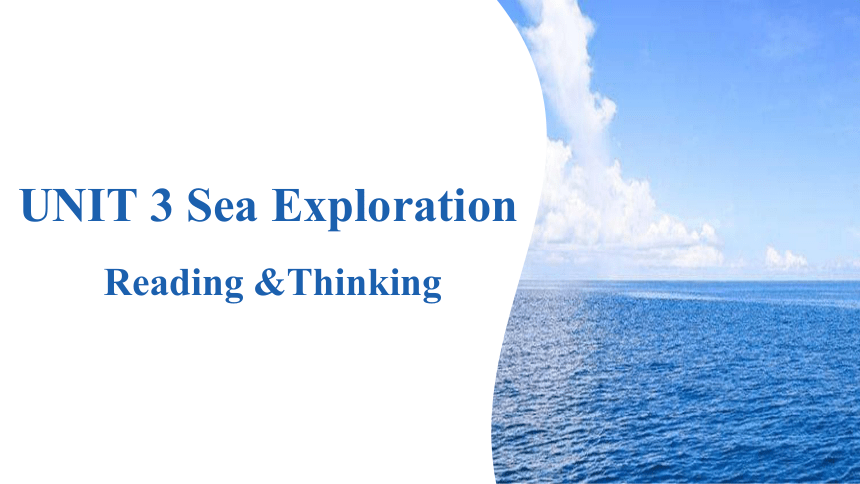 | |
| 格式 | pptx | ||
| 文件大小 | 27.2MB | ||
| 资源类型 | 教案 | ||
| 版本资源 | 人教版(2019) | ||
| 科目 | 英语 | ||
| 更新时间 | 2024-05-27 16:54:03 | ||
图片预览

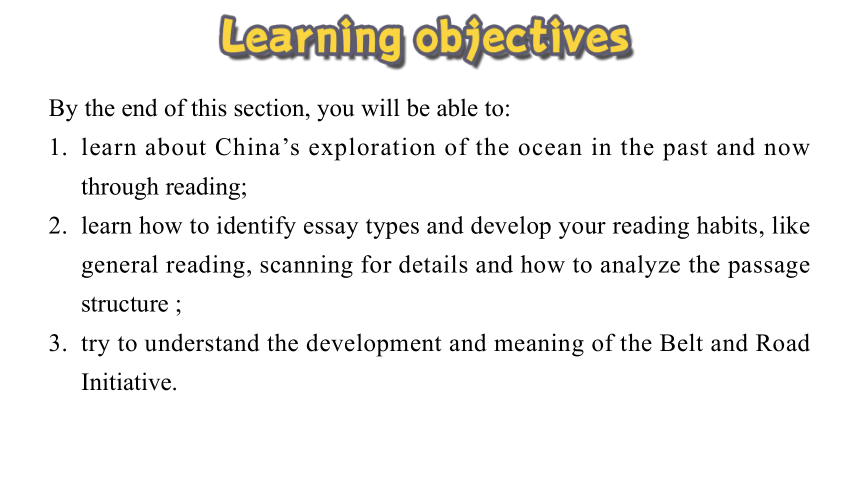

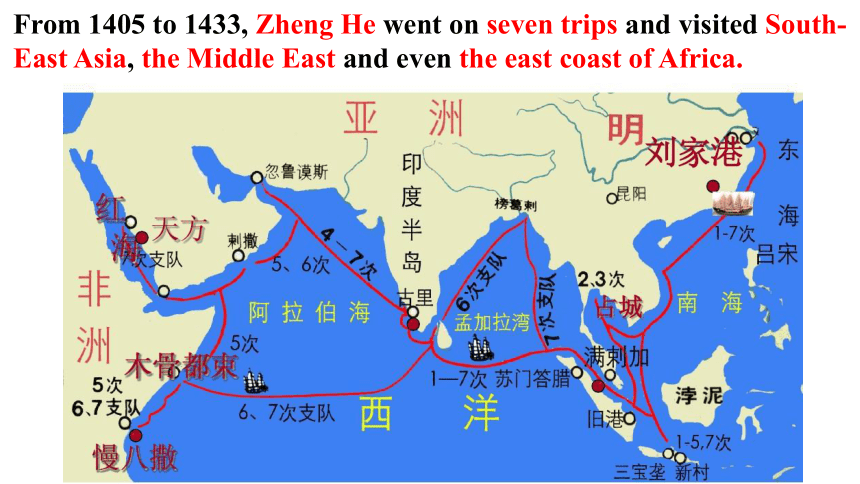
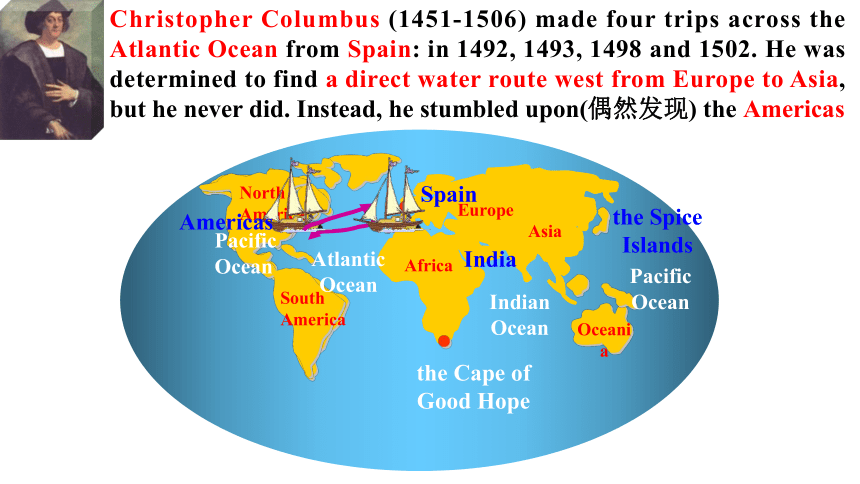
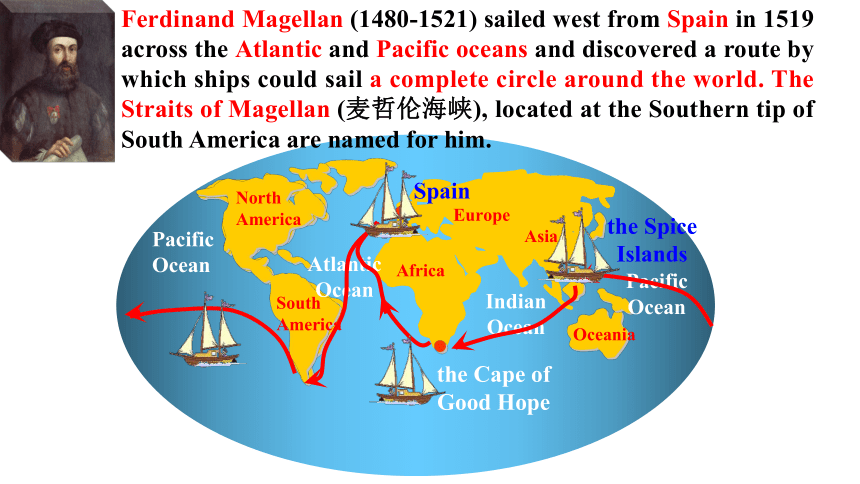
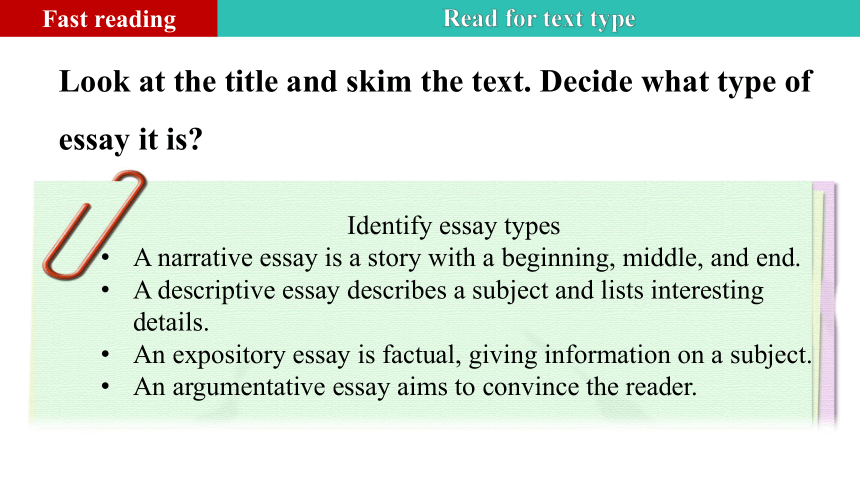
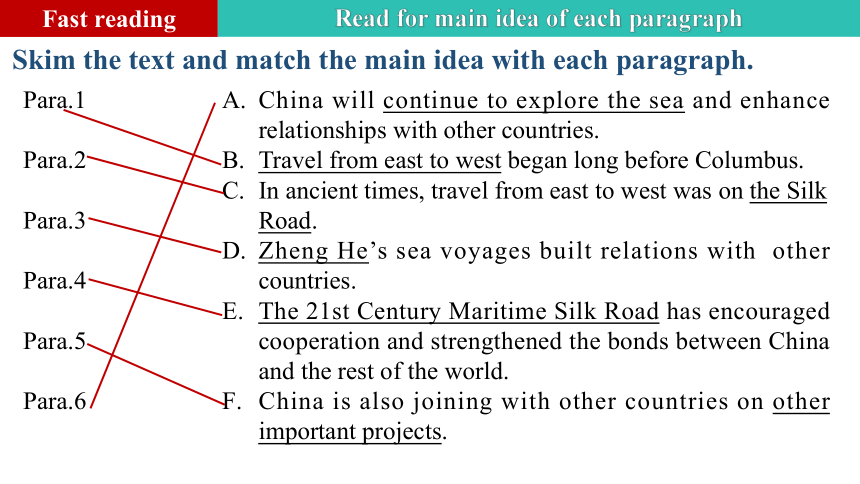
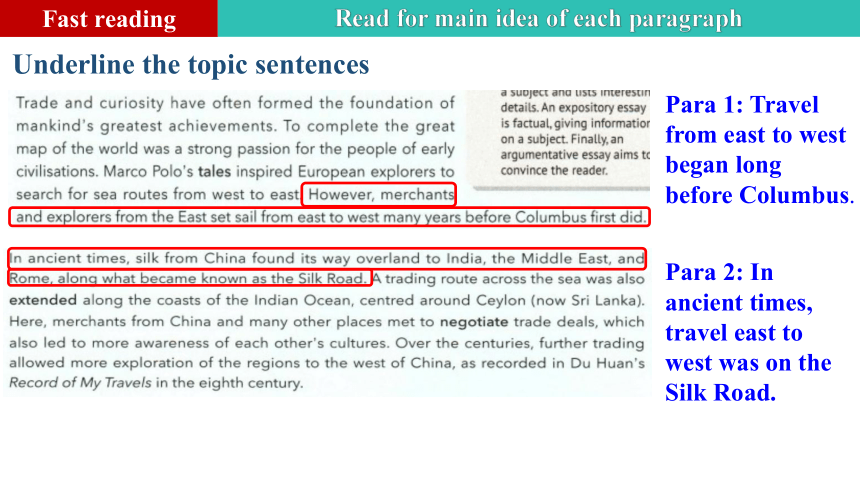
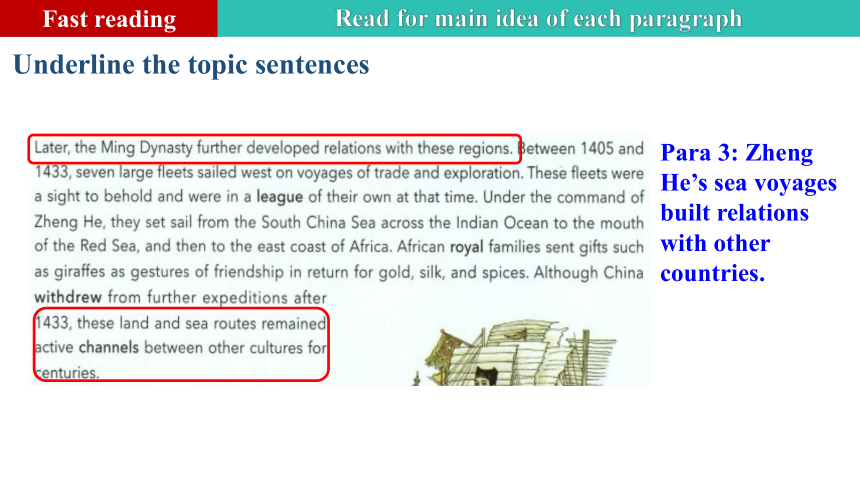
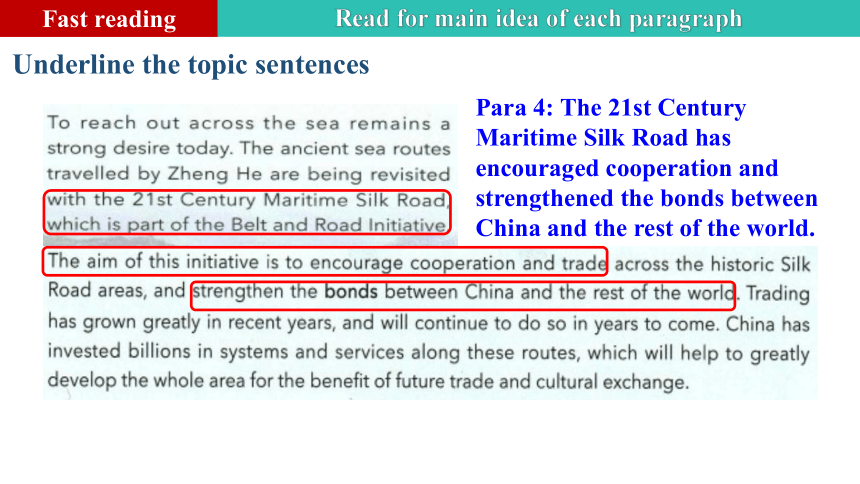
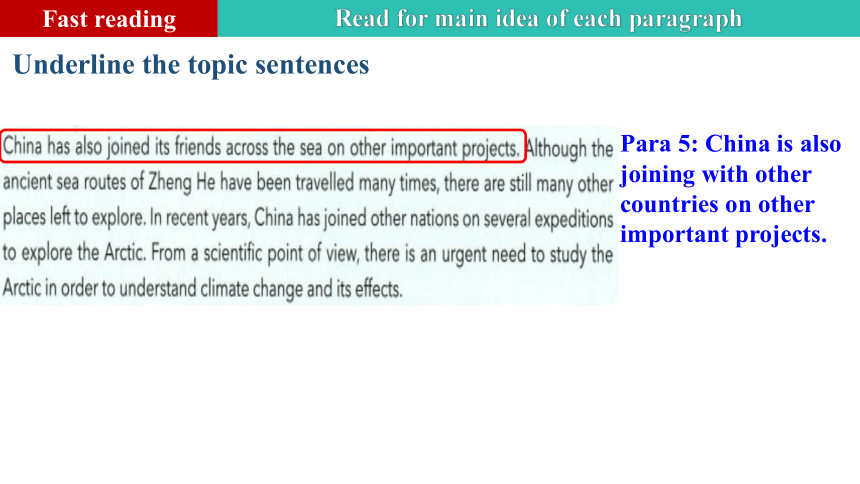
文档简介
(共33张PPT)
UNIT 3 Sea Exploration
Reading &Thinking
By the end of this section, you will be able to:
learn about China’s exploration of the ocean in the past and now through reading;
learn how to identify essay types and develop your reading habits, like general reading, scanning for details and how to analyze the passage structure ;
try to understand the development and meaning of the Belt and Road Initiative.
Do you know any stories about sea voyages & any famous navigators
Lead-in
From 1405 to 1433, Zheng He went on seven trips and visited South-East Asia, the Middle East and even the east coast of Africa.
Atlantic Ocean
Pacific Ocean
Indian Ocean
Asia
Europe
Africa
Oceania
North America
South America
Pacific Ocean
the Cape of Good Hope
the Spice Islands
India
Americas
Spain
Christopher Columbus (1451-1506) made four trips across the Atlantic Ocean from Spain: in 1492, 1493, 1498 and 1502. He was determined to find a direct water route west from Europe to Asia, but he never did. Instead, he stumbled upon(偶然发现) the Americas.
Atlantic Ocean
Pacific Ocean
Indian Ocean
Asia
Europe
Africa
Oceania
North America
South America
Pacific Ocean
the Cape of Good Hope
the Spice Islands
Spain
Ferdinand Magellan (1480-1521) sailed west from Spain in 1519 across the Atlantic and Pacific oceans and discovered a route by which ships could sail a complete circle around the world. The Straits of Magellan (麦哲伦海峡), located at the Southern tip of South America are named for him.
Fast reading
Read for text type
Look at the title and skim the text. Decide what type of essay it is
Narrative essay
Descriptive essay
Expository essay
Argumentative essay
Identify essay types
A narrative essay is a story with a beginning, middle, and end.
A descriptive essay describes a subject and lists interesting details.
An expository essay is factual, giving information on a subject.
An argumentative essay aims to convince the reader.
Skim the text and match the main idea with each paragraph.
Fast reading
Para.1
Para.2
Para.3
Para.4
Para.5
Para.6
China will continue to explore the sea and enhance relationships with other countries.
Travel from east to west began long before Columbus.
In ancient times, travel from east to west was on the Silk Road.
Zheng He’s sea voyages built relations with other countries.
The 21st Century Maritime Silk Road has encouraged cooperation and strengthened the bonds between China and the rest of the world.
China is also joining with other countries on other important projects.
Read for main idea of each paragraph
Para 1: Travel from east to west began long before Columbus.
Para 2: In ancient times, travel east to west was on the Silk Road.
Underline the topic sentences
Fast reading
Read for main idea of each paragraph
Para 3: Zheng He’s sea voyages built relations with other countries.
Underline the topic sentences
Fast reading
Read for main idea of each paragraph
Para 4: The 21st Century Maritime Silk Road has encouraged cooperation and strengthened the bonds between China and the rest of the world.
Underline the topic sentences
Fast reading
Read for main idea of each paragraph
Para 5: China is also joining with other countries on other important projects.
Underline the topic sentences
Fast reading
Read for main idea of each paragraph
Para 6: China will continue to explore the sea and enhance relationships with other countries.
Underline the topic sentences
Fast reading
Read for main idea of each paragraph
What is the order of the passage
compare and contrast
time sequence process problem and solution
compare and contrast cause and effect definition and description
Time
in ancient times
in the 8th century
in Ming Dynasty
today
in the future
Fast reading
Analyse the structure
Para
Para
Para
Introduction to the topic: Reaching out across the sea
Analyse the structure
Para 1
In the ancient times
In the future
In recent years
today
In Ming Dynasty
The passage is in a .
In the past
At present
In the future
2-3
4-5
6
General-particular pattern
General
particular
Fast reading
Analyse the structure
Read Para.1 and think why did the early explorers search for sea routes
Read Para.2-6, work in groups and find out the following information in each voyage.
What regions did the voyage cover
What was the event
What’s the purpose or the result accordingly
Detailed Reading
Why did the early explorers search for sea routes
A. To find the sea routes from east to west.
B. To discover the mysteries of the sea.
C. Being driven by curiosity and the need to trade.
D. Being inspired by Marco Polo’s tales.
Trade and curiosity have often formed the foundation of mankind’s greatest achievements. To complete the great map of the world was a strong passion for the people of early civilisations. Marco Polo’s tales inspired European explorers to search for sea routes from west to east. However, merchants and explorers from the East set sail from east to west many years before Columbus first did.
para 1
Detailed Reading
Time
Regions
Event
Result /
purpose
In ancient times
In the Ming Dynasty
Today
In the future
Work in groups and find out the following information in each voyage.
Para.2-6
Detailed Reading
regions
results
purpose
events
Para.2-6
Detailed Reading
regions
results
events
purpose
Para.2-6
Detailed Reading
purpose
regions
events
Para.2-6
Detailed Reading
regions
Para.2-6
Detailed Reading
events
purpose
regions
purpose
events
China, India, the Middle East, Rome, the coasts of the Indian Ocean and Sri Lanka
Time
Regions
Event
Result /
purpose
In ancient times
In the Ming Dynasty
Today
In the future
the South China Sea, the Indian Ocean, the mouth of the Red Sea, the east coast of Africa
the ancient sea routes travelled by Zheng He, the Belt and Road Area
the Arctic
The Silk Road
to negotiate trade deals;
be more aware of each other’s culture
trade and exploration,
friendship,
active channels
Zheng He sailed west
investment and services
trade
enhance relationships
the latest technologies
move towards a vaster sea
encourage cooperation and trade;
strengthen the bonds
develop the whole area for the benefit of future trade and cultural exchange.
understand climate change
and its effects
Para.2-6
Detailed Reading
What do you think is the significance of China’s reaching out across the sea
What do you think is the significance of the Belt and Road Initiative
Critical thinking
China’s sea exploration not only reflects the progress of human mind over time, but also demonstrate the fact that China is much stronger today than ever before. From expeditions for trading goods and making awareness of other cultures, to international cooperation and scientific research for the shared future of mankind, China is much more involved in international affairs and shoulders much greater responsibility for mankind.
1. What do you think is the significance of China’s reaching out across the sea
Critical thinking
2. What do you think is the significance of the Belt and Road Initiative
The Belt and Road Initiative is an “economic pie” that benefits the local population. Cooperation and trade across the historical Silk Road areas are encouraged and enhanced, and the bonds between China and the rest of the world are strengthened as well, which will lead to greater integration with China and other countries, in the hope of building a community of a shared future for mankind and achieve win-win development.
Critical thinking
Post-Reading
1. What inspired European explorers to search for sea routes from west to east
A. Trade and curiosity. B. The tales of Marco Polo.
C. The tales of Columbus. D. Merchants and explorers.
2.The Silk Road included the following places EXCEPT _____ A. India B. The Middle East C. Rome D. Japan
3.What did the trade deals between merchants from different countries result in
A. Further exploration of the oceans.
B. Mankind’s greatest achievements.
C. Construction of the ancient Silk Road.
D. Better understanding of each other’s culture.
Post-Reading
4. Zheng He and his fleets sailed as far as ________.
A. the Indian Ocean B. the South China Sea
C. the east coast of Africa D. the mouth of the Red Sea
6. Why is there an urgent need to study the Arctic
A. To promote foreign trade.
B. To look for more natural resources.
C. To strengthen the bonds between countries.
D. To know more about climate change and its effects.
Post-Reading
5.How can we describe Zheng He’s voyages at that time
A.Astonishing. B.Disappointing.
C.Frightening. D.Encouraging.
7. African royal families sent gifts such as giraffes to China in order to ________.
A.make money B.stop the war
C.show their friendship D.award the Ambassador
8. What is paragraph four mainly about
Zheng He’s travel along the ancient sea routes.
China’s development over the past century.
Trillions have been invested by China in systems and services along the routes.
The 21st Century Maritime Silk Road encourages cooperation between China and the rest of the world.
Post-Reading
Post-Reading
9. Which of the following statements are true according to paragraph five
Other countries do not welcome China’s participation in some projects.
There is an urgent need to carry out sea explorations.
China has solved the problem of climate change.
All the places have been explored by human beings.
10. What is the author attitude towards sea exploration
A. Supportive. B. Doubtful.
C. Opposed. D. Neutral.
THANKS
UNIT 3 Sea Exploration
Reading &Thinking
By the end of this section, you will be able to:
learn about China’s exploration of the ocean in the past and now through reading;
learn how to identify essay types and develop your reading habits, like general reading, scanning for details and how to analyze the passage structure ;
try to understand the development and meaning of the Belt and Road Initiative.
Do you know any stories about sea voyages & any famous navigators
Lead-in
From 1405 to 1433, Zheng He went on seven trips and visited South-East Asia, the Middle East and even the east coast of Africa.
Atlantic Ocean
Pacific Ocean
Indian Ocean
Asia
Europe
Africa
Oceania
North America
South America
Pacific Ocean
the Cape of Good Hope
the Spice Islands
India
Americas
Spain
Christopher Columbus (1451-1506) made four trips across the Atlantic Ocean from Spain: in 1492, 1493, 1498 and 1502. He was determined to find a direct water route west from Europe to Asia, but he never did. Instead, he stumbled upon(偶然发现) the Americas.
Atlantic Ocean
Pacific Ocean
Indian Ocean
Asia
Europe
Africa
Oceania
North America
South America
Pacific Ocean
the Cape of Good Hope
the Spice Islands
Spain
Ferdinand Magellan (1480-1521) sailed west from Spain in 1519 across the Atlantic and Pacific oceans and discovered a route by which ships could sail a complete circle around the world. The Straits of Magellan (麦哲伦海峡), located at the Southern tip of South America are named for him.
Fast reading
Read for text type
Look at the title and skim the text. Decide what type of essay it is
Narrative essay
Descriptive essay
Expository essay
Argumentative essay
Identify essay types
A narrative essay is a story with a beginning, middle, and end.
A descriptive essay describes a subject and lists interesting details.
An expository essay is factual, giving information on a subject.
An argumentative essay aims to convince the reader.
Skim the text and match the main idea with each paragraph.
Fast reading
Para.1
Para.2
Para.3
Para.4
Para.5
Para.6
China will continue to explore the sea and enhance relationships with other countries.
Travel from east to west began long before Columbus.
In ancient times, travel from east to west was on the Silk Road.
Zheng He’s sea voyages built relations with other countries.
The 21st Century Maritime Silk Road has encouraged cooperation and strengthened the bonds between China and the rest of the world.
China is also joining with other countries on other important projects.
Read for main idea of each paragraph
Para 1: Travel from east to west began long before Columbus.
Para 2: In ancient times, travel east to west was on the Silk Road.
Underline the topic sentences
Fast reading
Read for main idea of each paragraph
Para 3: Zheng He’s sea voyages built relations with other countries.
Underline the topic sentences
Fast reading
Read for main idea of each paragraph
Para 4: The 21st Century Maritime Silk Road has encouraged cooperation and strengthened the bonds between China and the rest of the world.
Underline the topic sentences
Fast reading
Read for main idea of each paragraph
Para 5: China is also joining with other countries on other important projects.
Underline the topic sentences
Fast reading
Read for main idea of each paragraph
Para 6: China will continue to explore the sea and enhance relationships with other countries.
Underline the topic sentences
Fast reading
Read for main idea of each paragraph
What is the order of the passage
compare and contrast
time sequence process problem and solution
compare and contrast cause and effect definition and description
Time
in ancient times
in the 8th century
in Ming Dynasty
today
in the future
Fast reading
Analyse the structure
Para
Para
Para
Introduction to the topic: Reaching out across the sea
Analyse the structure
Para 1
In the ancient times
In the future
In recent years
today
In Ming Dynasty
The passage is in a .
In the past
At present
In the future
2-3
4-5
6
General-particular pattern
General
particular
Fast reading
Analyse the structure
Read Para.1 and think why did the early explorers search for sea routes
Read Para.2-6, work in groups and find out the following information in each voyage.
What regions did the voyage cover
What was the event
What’s the purpose or the result accordingly
Detailed Reading
Why did the early explorers search for sea routes
A. To find the sea routes from east to west.
B. To discover the mysteries of the sea.
C. Being driven by curiosity and the need to trade.
D. Being inspired by Marco Polo’s tales.
Trade and curiosity have often formed the foundation of mankind’s greatest achievements. To complete the great map of the world was a strong passion for the people of early civilisations. Marco Polo’s tales inspired European explorers to search for sea routes from west to east. However, merchants and explorers from the East set sail from east to west many years before Columbus first did.
para 1
Detailed Reading
Time
Regions
Event
Result /
purpose
In ancient times
In the Ming Dynasty
Today
In the future
Work in groups and find out the following information in each voyage.
Para.2-6
Detailed Reading
regions
results
purpose
events
Para.2-6
Detailed Reading
regions
results
events
purpose
Para.2-6
Detailed Reading
purpose
regions
events
Para.2-6
Detailed Reading
regions
Para.2-6
Detailed Reading
events
purpose
regions
purpose
events
China, India, the Middle East, Rome, the coasts of the Indian Ocean and Sri Lanka
Time
Regions
Event
Result /
purpose
In ancient times
In the Ming Dynasty
Today
In the future
the South China Sea, the Indian Ocean, the mouth of the Red Sea, the east coast of Africa
the ancient sea routes travelled by Zheng He, the Belt and Road Area
the Arctic
The Silk Road
to negotiate trade deals;
be more aware of each other’s culture
trade and exploration,
friendship,
active channels
Zheng He sailed west
investment and services
trade
enhance relationships
the latest technologies
move towards a vaster sea
encourage cooperation and trade;
strengthen the bonds
develop the whole area for the benefit of future trade and cultural exchange.
understand climate change
and its effects
Para.2-6
Detailed Reading
What do you think is the significance of China’s reaching out across the sea
What do you think is the significance of the Belt and Road Initiative
Critical thinking
China’s sea exploration not only reflects the progress of human mind over time, but also demonstrate the fact that China is much stronger today than ever before. From expeditions for trading goods and making awareness of other cultures, to international cooperation and scientific research for the shared future of mankind, China is much more involved in international affairs and shoulders much greater responsibility for mankind.
1. What do you think is the significance of China’s reaching out across the sea
Critical thinking
2. What do you think is the significance of the Belt and Road Initiative
The Belt and Road Initiative is an “economic pie” that benefits the local population. Cooperation and trade across the historical Silk Road areas are encouraged and enhanced, and the bonds between China and the rest of the world are strengthened as well, which will lead to greater integration with China and other countries, in the hope of building a community of a shared future for mankind and achieve win-win development.
Critical thinking
Post-Reading
1. What inspired European explorers to search for sea routes from west to east
A. Trade and curiosity. B. The tales of Marco Polo.
C. The tales of Columbus. D. Merchants and explorers.
2.The Silk Road included the following places EXCEPT _____ A. India B. The Middle East C. Rome D. Japan
3.What did the trade deals between merchants from different countries result in
A. Further exploration of the oceans.
B. Mankind’s greatest achievements.
C. Construction of the ancient Silk Road.
D. Better understanding of each other’s culture.
Post-Reading
4. Zheng He and his fleets sailed as far as ________.
A. the Indian Ocean B. the South China Sea
C. the east coast of Africa D. the mouth of the Red Sea
6. Why is there an urgent need to study the Arctic
A. To promote foreign trade.
B. To look for more natural resources.
C. To strengthen the bonds between countries.
D. To know more about climate change and its effects.
Post-Reading
5.How can we describe Zheng He’s voyages at that time
A.Astonishing. B.Disappointing.
C.Frightening. D.Encouraging.
7. African royal families sent gifts such as giraffes to China in order to ________.
A.make money B.stop the war
C.show their friendship D.award the Ambassador
8. What is paragraph four mainly about
Zheng He’s travel along the ancient sea routes.
China’s development over the past century.
Trillions have been invested by China in systems and services along the routes.
The 21st Century Maritime Silk Road encourages cooperation between China and the rest of the world.
Post-Reading
Post-Reading
9. Which of the following statements are true according to paragraph five
Other countries do not welcome China’s participation in some projects.
There is an urgent need to carry out sea explorations.
China has solved the problem of climate change.
All the places have been explored by human beings.
10. What is the author attitude towards sea exploration
A. Supportive. B. Doubtful.
C. Opposed. D. Neutral.
THANKS
